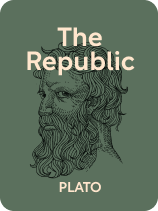

This article is an excerpt from the Shortform book guide to "The Republic" by Plato. Shortform has the world's best summaries and analyses of books you should be reading.
Like this article? Sign up for a free trial here.
What’s Plato’s primary argument in The Republic? Why did he choose to write in the form of dialogues?
In The Republic, Plato provides one of the foundations of the Western philosophical canon. He gives key arguments, images, and allegories about morality, politics, and knowledge. This includes but isn’t limited to Plato’s ideal city, his concept of philosopher kings, and his allegory of the cave.
Continue reading for our overview of The Republic by Plato.
Overview of Plato’s Republic
In The Republic, Plato defines justice, the human soul, the ideal society, and the foundational structure of the universe itself through dramatic scenes, metaphors, and arguments. He intertwines these complicated topics to argue that living morally is good for its own sake. Writing in 375 BCE during the decline of the Athenian empire, Plato critiques his society while providing an alternative set of values based on philosophy, truth, and knowledge. In our overview of the The Republic, we’ll outline Plato’s main arguments in five parts:
- Part 1: The Challenge to Justice sets up Plato’s overall project of proving that living justly and morally is good for its own sake.
- Part 2: Creating the Ideal City outlines a perfectly just city to reveal the nature of justice.
- Part 3: The Philosopher-Rulers describes the perfectly just ruler of the ideal city.
- Part 4: Inferior Cities goes through imperfect, less just cities and the men who are emblematic of them.
- Part 5: Answering the Challenge compares the ideal and inferior men to show why justice is inherently good.
(Shortform note: Plato wrote all of his philosophy in the form of dialogues, or fictional conversations between characters. This allowed him to add extra depth and nuance not just through what is said, but also through who says it and how they say it. Most of the characters in Plato’s dialogues are based on real people who lived in 4th-century BCE Athens. Throughout the overview, we’ll note who the characters are and what they represent when appropriate.)
Part 1: The Challenge to Justice (Books I-II)
Plato starts The Republic by establishing his main thesis: Justice, or acting morally, is good for its own sake. He opens with the philosopher Socrates and his student Glaucon taking a trip to the port of Athens, which gets interrupted when the wealthy merchant Cephalus demands they visit him. After a brief discussion on old age and wealth, Socrates questions Cephalus’s perspective and the old man departs. Then, Socrates and the remaining young men discuss the definition of justice.
The discussion of justice contains the following points:
- A conventional definition of justice that proves insufficient
- A definition of justice as “might is right” that describes justice as a tool for self-interest
- The challenge to Socrates, which sets up Plato’s thesis and how he’ll defend it
The Conventional Definition of Justice
Cephalus’s son Polemarchus opens the discussion of justice with a relatively conventional definition: Justice means honoring your contracts, helping your friends, and harming your enemies.
Refuting the First Definition
Socrates disagrees with this first definition of justice. He notes that, according to this definition, you could mistake a friend for an enemy and hurt the wrong person—or vice versa—and it would still count as just. He also suggests that a truly just person doesn’t harm anyone. A just person aims to make the world and everyone in it more just. So while they might cause someone pain—punishing them for a crime, for example—they’ll only do so if that pain helps their enemy become a better, more just person.
The Second Definition of Justice: Might Makes Right
After Socrates refutes the first definition of justice, philosopher and rhetorician Thrasymachus jumps into the conversation with his definition: Justice is whatever benefits the strong. In other words, justice is a tool powerful people use for their self-interest. The powerful define justice and morality in a way that gets them what they want, and the weak obey it because they have no other choice. Therefore, the powerful aren’t bound by the same standards of morality as the weak—they can do whatever they want, so long as they’re strong enough to get away with it.
The Challenge to Socrates
Socrates offers several arguments against Thrasymachus’s view of justice, but Glaucon and his brother Adeimantus find them unsatisfactory. They challenge Socrates to prove Thrasymachus wrong by showing that justice is good for its own sake—in other words, justice has inherent value beyond a way for people to get what they want.
To frame this challenge, Glaucon and Adeimantus play “devil’s advocate” by offering an argument similar to Thrasymachus’s. Then, they provide the specific terms of the challenge.
The Case for Injustice
Glaucon and Adeimantus make the case that justice is good only because it provides other benefits. Glaucon and Adeimantus argue people aren’t just because they want to be. Instead, they follow the rules of society and act justly to avoid the consequences of being unjust: a bad reputation, trouble with the law, judgment in the afterlife, and so on. Therefore, justice isn’t inherently good.
To further illustrate this point, Glaucon cites the myth of Gyges, a story about a man who finds a ring that turns him invisible. Gyges then uses this ring to rob and kill his way to power and wealth. Glaucon argues that anyone with this ring would use it to commit unjust deeds in pursuit of their selfish desires because there would be no consequences for their actions.
The Terms of the Challenge
To define their challenge to Socrates, Glaucon and Adeimantus invent two hypothetical men:
- A perfectly unjust man who everyone believes is just, and who has all the benefits of being seen that way: He’s greatly respected and admired, is in no legal trouble, and has a great deal of wealth and power.
- A perfectly just man who everyone believes is unjust, and who faces all the consequences of being seen that way: He’s despised, imprisoned, and poor.
The first man is unjust, but gains all the benefits of being just. On the other hand, the second man is just, but it provides him no benefits in life. If Socrates can prove that the second (just) man lives a preferable life to the first (unjust) man, he’ll prove that justice is good not because of the benefits it provides but for its own sake.
Part 2: Creating the Ideal City (Books II-IV)
To answer his challenge, Socrates sets out to first describe the perfectly just man. He suggests that the soul of a man is a lot like a society—both can be described as ”just,” and both are made up of components working together to form a cohesive whole. In addition, Socrates says, justice is easier to observe and describe on the scale of an entire society than it is in the life of an individual. Therefore, he describes a perfectly just society to serve as an analogy for a perfectly just individual.
We’ll discuss the perfectly just city described in The Republic.
The Class System
Socrates argues that an ideal city has a class system enforced by the government. Different people are good at different things, Socrates explains, and in an ideal city everyone performs the role best suited to them. Therefore, people must be assigned to their ideal roles and must remain in them to develop their skills.
Socrates separates the ideal city into two overall classes: the workers and the protectors.
1) The Workers
Socrates explains that the workers perform the labor necessary for the function of a city, acting as farmers, tradespeople, merchants, doctors, and so on. Because they’re experts at these technical skills and not politics, workers in the ideal city have no political power. Socrates acknowledges that a powerless class could grow discontent, though, and suggests that the city permit workers to own private property and a large majority of the wealth they create. Then, they’ll be satisfied with their various luxuries and won’t cause unrest.
2) The Protectors
The protectors serve as the military, police, and executive officials of the ideal city, carrying out the law but not creating it. Socrates explains that children who show the qualities of a good protector—courage, physical fitness, and so on—are taken from their families to live separate from the city. There, they live communal and minimalist lifestyles so they don’t become accustomed to or desire material wealth. They receive extensive moral and physical education teaching them to use their power for the good of the city as a whole and not for their ambitions. Once they come of age, they’ll strategically breed to create the most capable offspring and raise them communally as well.
The Noble Lie
Socrates believes that to ensure the stability of the ideal city and keep people satisfied with its strict class system, the city must use a noble lie, or a myth about the city that justifies its class system. According to the noble lie, people in the ideal city are born from the earth with certain metals in them. Those with gold in them are destined to be rulers, those with silver will be protectors, and those with bronze will be workers. Any disruption of this system will destabilize and harm the ideal city.
Part 3: The Philosopher-Rulers (Books V-VII)
After discussing the overall structure of the ideal city, Socrates discusses who will lead it. He argues that philosophers make the best leaders, and describes a class of philosopher-rulers: a select group of protectors who act as the moral leaders and guides of the ideal city. These rulers are emblematic of the city itself and provide a model of a perfectly just life—the kind of life Socrates must prove is preferable in order to win the challenge.
In books V through VII of The Republic, Socrates uses three allegories to show why philosophers are ideal rulers:
- The allegory of the ship shows why philosophers have the character of an ideal ruler.
- The allegory of the divided line explains why an ideal ruler needs philosophical knowledge.
- The allegory of the cave describes how a philosopher uses their knowledge to rule.
Allegory #1: The Ship
To illustrate the philosophical character and why it’s ideal for ruling, Socrates uses the allegory of a ship and its crew. There are three types of people on the ship: 1) The captain of the ship isn’t a good seaman, but he’s physically strong and charismatic enough to keep everyone else in line. 2) The sailors aren’t much better than him at seafaring, but they desire power—constantly scheming to trick or force the captain to hand over his role. 3) The navigator avoids petty power struggles and instead dedicates himself to learning about weather, astronomy, and other seafaring skills. This makes him an excellent seaman, but nobody listens to him because he can’t help them gain power.
Understanding the Ship
This ship serves as an allegory for Athens. The incompetent captain and power-hungry sailors represent politicians and orators, while the navigator represents the philosopher. Just as the navigator has the necessary seafaring knowledge to guide the ship, the philosopher has the necessary moral knowledge to guide society. And just as the navigator avoids petty power politics and is ignored as a result, philosophers aren’t interested in power and wealth and are therefore ignored.
Socrates argues that just as the navigator is the ideal leader of the ship, the philosopher is the ideal ruler of society. The philosopher’s lack of interest in power and wealth means they’ll be less corrupt, while their focus on knowledge makes them the most competent. Their dedication to knowledge also requires self-control and the courage to keep searching for answers to abstract, universal questions—all ideal qualities in a ruler.
Allegory #2: The Divided Line
To further elaborate on why philosophical knowledge is superior for guiding society, Socrates outlines his theory of human thought and knowledge.
According to Socrates, there’s a hierarchy of human thought—some thoughts or claims are better than others. He argues that the more provable, universal, and unchanging a thought is, the better it is because these criteria determine how certain we can be of its truth. To further illustrate this hierarchy of truth, Socrates compares thoughts to objects in the world. He categorizes them in a line divided into several sections.
Each row of the divided line represents a different category of thought. Let’s explore the hierarchy of these categories in more detail.
Lowest Level: Illusions and Images
Illusions are beliefs not backed by evidence. Socrates says these are therefore the lowest form of knowledge, as very little suggests they’re true. For example, the popular idea that “sunflowers always point toward the sun” is an illusion; it’s commonly repeated and believed even though it has little to no evidence behind it. Socrates compares illusions to our perceptions of images or shadows in the world around us—you see your reflection in a mirror, but there isn’t another real copy of you behind or within it.
Second Level: Opinions and Objects
Opinions are beliefs backed by evidence. They’re therefore superior to illusions but still don’t provide concrete knowledge. For example, there’s plenty of evidence that gravity exists, but we can’t be certain it does or that it always will. Socrates compares opinions to our perceptions of physical objects. We can see and touch a table to see if it’s there, but those perceptions are still founded on assumptions—that we know what a table is, that our faculties are working correctly, and so on.
Third Level: Knowledge and the Forms
Knowledge is provably universally true and unchanging. Socrates explains that we can arrive at knowledge through mathematical and philosophical reasoning. For example, we can use mathematical reasoning to prove that two plus two always equals four and will never stop equalling four. Therefore, we know that two plus two equals four. Similarly, Socrates suggests that philosophical reasoning and debate can provide provable, universal, and unchanging definitions of concepts like justice and beauty.
Socrates explains that knowledge is to thought as forms are to reality. The forms, he explains, are unchanging, universal, perfect versions of objects and concepts that exist in a separate realm. Objects imitate or derive from these forms in the same way that images derive from objects. For example, we understand what a perfect circle is in theory, but all existing circles in the world have flaws, however minuscule, that make them imperfect. The theoretical perfect circle is the form of a circle, and existing circles all derive from that form. All objects—from tables to fish to rocks—derive from their corresponding forms. They can also derive from the forms of concepts—a beautiful table derives from the form of beauty, for example.
Highest Level: The Form of the Good and the Sun
Socrates argues that all forms—and the objects and images that derive from them—derive from the form of the good. Since the forms are perfect ideals, they must be good. You wouldn’t call a perfect circle a bad circle, for example.
Moreover, knowledge—the way we determine what is true and how we grasp reality—comes from an understanding of the forms. Therefore, the form of the good is the ultimate source of all knowledge and truth. Socrates compares the form of the good to the sun: Just as the sun provides the warmth for things to grow and the light for us to perceive them, the form of the good provides the reality for us to study and the truth for us to make sense of it.
Allegory #3: The Cave
After explaining the superiority of philosophical character and philosophical knowledge, Socrates describes how these elements combine to create an ideal ruler. He does so through an allegory of a cave, which describes the education and leadership of the ideal city’s philosopher-ruler.
Inside the cave, people are restrained so they permanently face the back wall. A fire is lit behind them, and various items are placed in front of it to project shadows on the wall. Because they’ve never seen anything else, the people in the cave believe these shadows are actual real objects. But one day, a man frees himself from his restraints, turns around, sees the items in front of the fire, and realizes the shadows are just images cast by them. Then, as his eyes adjust to the light, he’s able to ascend from the cave, see reflections and objects outside, and then eventually look up to see the sky. There, he’ll finally see that the sun provides the necessary light for all objects and shadows to be visible.
If he returns to the cave, his eyes will struggle to adapt to the darkness, and everyone inside will assume he’s delusional if he tries to explain what he’s seen outside. While he would prefer to spend all his time outside and see the true world, he knows he must return for the good of everyone in the cave—his community. When he does, he’ll understand the shadows far better than anyone else inside because he’s seen the objects that create them. He’ll therefore be far better suited to educating and guiding everyone else.
Understanding the Cave
Combined with an understanding of the divided line, the allegory of the cave represents the role of a philosopher-ruler in society. In mundane society, people are focused entirely on conventional wisdom and worldly affairs like wealth and petty politics—just as people inside the cave are focused on shadows.
But those with a philosophical character find worldly affairs insufficient to explain the nature of the world around them. In the ideal city, they’re selected from the protectors and educated to become philosophers. This education mirrors the ascent from the cave, going from basic, universal education (illusions and objects) to mathematical reasoning, philosophical reasoning, and the form of the good (the sky and sun). This process lasts several decades, allowing the philosopher-ruler’s mind to adjust to this new understanding of reality just as the cave man’s eyes adjusted to the light.
Because of their love of knowledge, the philosopher-rulers will want to keep studying the forms indefinitely. However, they’ll recognize that they must rule because they’re best suited to the task—refusing would be placing their desires over the well-being of the city as a whole. Therefore, they’ll “descend” back into the cave to educate those still within it about the best, most moral ways to live their lives and run society.
Part 4: Inferior Cities (Books VIII-IX)
Once Socrates has described the nature of the ideal city, he acknowledges that it will inevitably deteriorate over time. He explains that, in the world of objects, change is inevitable. Since the city is already perfect, any change will be negative—and even the smallest negative changes will eventually accumulate into a broader decline.
Socrates describes this decline in terms of four inferior cities, each worse than the last:
- Timocracy: a society structured around honor and ambition
- Oligarchy: a society structured around wealth
- Democracy: a society structured around personal freedom
- Tyranny: a society structured around oppression and mob rule
In addition, he offers a personality representative of each, just as the philosopher-ruler represents the values of the ideal city. This continues his analogy of justice in society and justice in an individual. We’ll explain the nature of each inferior city and man, how they come to be, and why they’re inferior to the ideal city or philosopher-ruler.
Step #1: Timocracy
A timocracy is a society where politics revolve around military prowess and honor, explains Socrates. In a timocracy, military and political offices are the same, and rulers are judged by their military successes.
The ideal city starts becoming a timocracy when, by chance, there’s a generation of less competent rulers and protectors. They’ll provide inferior education to the next generation, starting a cumulative decline. This eventually leads to rulers and protectors who venerate the physical and military ideals of the city but lack philosophical knowledge. Without this knowledge, they can’t understand who belongs to which class. Incorrectly assigning citizens will cause civil strife, and the timocratic rulers and protectors will have to enforce stability through violence and oppression against the workers.
The Timocratic Man
Socrates describes the timocratic man as good-natured, conflicted, and ambitious. He wants to be excellent and values his physical and military training. His father—a philosopher—teaches him to avoid the corruption of public life and that goodness is reached through reason and knowledge. However, the rest of society judges his father harshly for his lack of military prowess and honor. The timocratic man tries to avoid this judgment while also maintaining some of his father’s principles. This middle ground between the desire for glory and the desire for goodness is ambition and a competitive drive.
The timocratic man also secretly desires wealth and the luxuries it provides. This is because his inferior education never convinced him that wealth corrupts—it just forced him to give it up.
Step #2: Oligarchy
An oligarchy is a society where wealth is equal to political power, explains Socrates. In an oligarchy, wealth is equated with goodness and is a requirement for ruling.
A timocracy becomes an oligarchy when secret desires for luxury cause timocrats to continue accumulating wealth. As they do, they become less interested in personal excellence and more interested in managing their riches. This eventually erodes and then reverses their belief that wealth is corrupting. Oligarchies often have incompetent rulers, as wealth doesn’t translate to political skill. In addition, the sharp divide between rich and poor in an oligarchy creates further civil strife as the poor become vagrants and criminals.
The Oligarchic Man
According to Socrates, the oligarchic man is only concerned with making money. A political scandal or failure destroyed the life of his father—a timocrat. In an attempt to avoid poverty and misery by any means necessary, the oligarchic man abandons his moral principles and directs his ambition exclusively toward gaining wealth. He’s only honest when it benefits his reputation as a businessman and only restrains his hedonistic desires out of stinginess. In addition, he’s not courageous and gives up easily since he has to abandon any pursuit that might lose him money.
Step #3: Democracy
A democratic society is defined by equal rights, freedoms, and political opportunities for all citizens, Socrates explains. In a democracy, people are free to live however they choose. Because of this, democratic societies have a lot of different ideas and perspectives.
An oligarchy becomes a democracy when younger generations spend their wealth extravagantly and without restraint. This is inevitable because maximizing profits requires enabling immoral behaviors—there’s money to be made not only in selling extravagant luxuries but also in exploiting the financially reckless. This also increases wealth inequality even further until there’s nothing but the desperately poor and the pampered, incompetent rich. When civil strife from inequality boils over, the poor revolt, overthrow the oligarchy, and grant everyone equal rights and opportunities.
The Democratic Man
Socrates describes the democratic man as flexible but unprincipled. His father—an oligarch—teaches him to be stingy, make money, and avoid unnecessary expenses. But others around him in society indulge in extravagance and excess, and the democratic man gets a taste for luxury from spending time with them. They tell him this extravagance is the best way to live, and the democratic man believes them because he hasn’t been taught strong moral principles. And so the democratic man takes a middle ground between his father’s views and his society: He doesn’t constantly indulge in excess but he’s not stingy either. He’s also unwilling to judge those who indulge or say any pleasure is good or bad.
Step #4: Tyranny
Socrates says a tyrannical society is governed by mob rule, violence, and oppression. It’s run by a single charismatic leader—a tyrant—who appeals to the people but only cares about himself.
A democracy becomes a tyranny through conflict between the rich and poor. In a democracy, the rich and poor have equal rights and freedoms but unequal wealth. Therefore, a charismatic leader can mobilize the poor by promising to persecute their enemies and redistribute wealth. Using the legal system and mob violence, this leader eliminates their political opponents and secures their power. They can then use wealth seized from the rich to hire a private army and oppress the masses for their personal benefit.
The Tyrannical Man
According to Socrates, the tyrannical man is ruled by his violent, animalistic desires. His father—a democrat—teaches him that indulging in pleasure is OK if he practices moderation. On the other hand, his society teaches him to indulge extravagantly as much as he likes. And since his father refuses to judge people for indulging in pleasures, he doesn’t stop the tyrannical man from giving himself over to his desires. The tyrannical man spends his time having wild orgies, getting drunk, and eating to excess. When he runs out of money to feed his habits, he lies and cheats to get more. If that fails, he robs and kills people.
Part 5: Answering the Challenge (Book X)
After outlining the nature of just and unjust societies and how they correspond to individuals, Socrates returns to the original challenge: proving that a just person lives a better life than an unjust person. To answer this challenge, he shows how the philosopher-ruler—the representative of the perfectly just city—is better off in life and death compared to the representatives of the inferior cities.
The Preferable Life
Socrates argues that the philosopher-ruler lives the best life of the individuals he has described. Because the philosopher-ruler has the most knowledge and best understanding of the world, he knows which pleasures in life are greatest and which are fleeting or lead to future pain. He prioritizes the pleasure found in pursuing and obtaining knowledge, which is the most real and permanent kind of pleasure—after all, it involves the true and unchanging forms. But he also allows himself to enjoy physical pleasures or the pleasure of being honored when appropriate.
The other individuals Socrates describes have less knowledge and therefore are worse at choosing which pleasures to pursue. This means they’re more likely to choose fleeting pleasures or pleasures that lead to pain. They also neglect the pleasure of obtaining knowledge in favor of other, less real pleasures. The further a man is from the philosopher-ruler, the worse pleasures he pursues and the worse his life will be. For example, the tyrannical man pursues the most fleeting pleasures—food, drink, and sex—even as it leads to pain in the form of violence, drunken madness, death, and so on. He therefore leads the worst life.
The Preferable Afterlife
Socrates finishes by explaining that, regardless of how fortunate or unfortunate someone is in life, justness is rewarded after death. He illustrates this principle with a myth about a man named Er.
The Myth of Er
According to Socrates, Er was a man who died in battle only to return to life 12 days later. He explained that while dead, his soul and many others were judged for their actions. The just were rewarded for their deeds in life while the unjust were punished. Then, the souls chose new bodies to inhabit for their next lives—human or animal.
Wise, good souls knew which lives would be good and chose accordingly. Some of the unjust learned from their mistakes and chose better lives, while others refused to admit they were at fault and chose lives just as bad as their previous ones. On their way back to earth to live their new lives, they drank water of forgetfulness and lost all memory of their ordeal—save for Er, who was told to return to his body and tell everyone what he’d seen to encourage them to live better lives.

———End of Preview———
Like what you just read? Read the rest of the world's best book summary and analysis of Plato's "The Republic" at Shortform.
Here's what you'll find in our full The Republic summary:
- Plato’s concept of justice
- Why living a moral life is good for its own sake
- How later philosophers interpreted and responded to the ideas in The Republic






